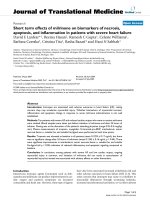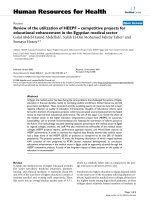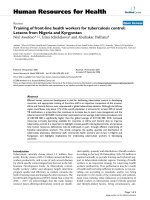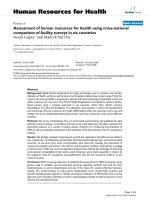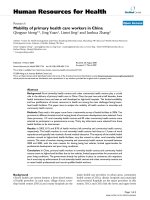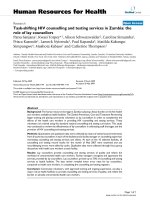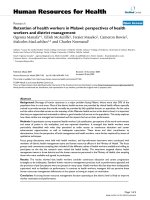Báo cáo sinh học: "Increase of plasma IL-9 and decrease of plasma IL-5, IL-7, and IFN-g in patients with chronic heart failure" potx
Bạn đang xem bản rút gọn của tài liệu. Xem và tải ngay bản đầy đủ của tài liệu tại đây (663.92 KB, 7 trang )
RESEARCH Open Access
Increase of plasma IL-9 and decrease of plasma IL-5,
IL-7, and IFN-g in patients with chronic heart failure
Claudia Cappuzzello
1†
, Luca Di Vito
2†
, Roberta Melchionna
3
, Guido Melillo
3
, Lorena Silvestri
4
, Eleonora Cesareo
5
,
Filippo Crea
2
, Giovanna Liuzzo
2
, Antonio Facchiano
3
, Maurizio C Capogrossi
3
, Monica Napolitano
3*
Abstract
Background: Several cytokines are associated with the development and/or progression of chronic heart failure
(CHF). Our aim was to look more closely at the cytokine networks involved in CHF, and to assess whether disease
etiology affects cytokine expression. The study population was comprised of a) 69 patients with stable CHF, New
York Heart Association (NYHA) II/IV classes, secondary to ischaemic (ICM) and non ischaemic dilated (NIDCM)
cardiomyopathy and b) 16 control subjects. We analyzed and compared the plasma levels of 27 pro- and anti-
inflammatory mediators, in the study population and assessed for any possible correlation with echocardiographic
parameters and disease duration.
Methods: 27 cytokines and growth factors were analyzed in the plasma of ICM- (n = 42) and NIDCM (n = 27)
NYHA class II-IV patients vs age- and gender-matched controls (n = 16) by a beadbased multiplex immunoassay.
Statistical analysis was performed by ANOVA followed by Tukey post-hoc test for multiple comparison.
Results: Macrophage inflammatory protein (MIP)-1b, Vascular endothelial growth factor (VEGF), interleukin (IL)-9,
Monocyte chemotactic protein (MCP)-1, and IL-8 plasma levels were increased in both ICM and NIDCM groups vs
controls. In contrast, IL-7, IL-5, and Interferon (IFN)-g were decreased in both ICM and NIDCM groups as compared
to controls. Plasma IL-6 and IL-1 b were increased in ICM and decreased in NIDCM, vs controls, respectively .
IL-9 levels inversely correlated, in ICM patients, with left ventricular ejection fraction (LVEF) while IL-5 plasma levels
inversely correlated with disea se duration, in NYHA III/IV ICM patients.
This is the first time that both an increase of plasma IL-9, and a decrease of plasma IL-5, IL-7 and IFN-g have been
reported in ICM as well as in NIDCM groups , vs controls. Interestingly, such cytokines are part of a network of
genes whose expression levels change during chronic heart failure. The altered expression levels of MIP-1 b, VEGF,
MCP-1, IL-1 b, IL-6, and IL-8, found in this study, are in keeping with previous reports.
Conclusions: The increase of plasma IL-9, and the decrease of plasma IL-5, IL-7 and IFN- g in ICM as well as in
NIDCM groups vs controls may contribute to get further insights into the inflammatory pathways involved in CHF.
Background
The r ole of inflammation in the pathogenesis and pro-
gression of chronic heart failure (CHF) is well estab-
lished [1,2]. Typical hallmarks for t he involvement of
immune mechanisms in CHF pathogenesis are the acti-
vation/migration of leukocytes from the circulation to
the a reas of myocardial inflammation and an increased
expression of pro inflammatory cytokines, such as tumor
necrosis factor a, interleukin-1, and interleukin-6 from a
damaged myocardium [3-6]. In heart failure such cyto-
kine levels increase in association with disease severity
and may contribute to impair cardiac function through
cardiomyocyte apoptosis, inflammatory response, cardiac
hypertrophy and matrix metalloproteinase activation
[1,7-9].
Proinflammatory cytokines may cause myocyte apop-
tosis and necrosis; interleukin-6 induces a hypertrophic
response in myocytes [10], whereas TNF-a causes left
ventricular dilatation, apparently through the activation
of matrix metalloproteinases [11]. Elevated levels of
CXC and C-C chemokines such as GROa, IL-8, MCP-1,
* Correspondence:
† Contributed equally
3
Laboratorio di Patologia Vascolare, Istituto Dermopatico dell ’ Immacolata-
IRCCS, Rome, Italy
Full list of author information is available at the end of the article
Cappuzzello et al. Journal of Translational Medicine 2011, 9:28
/>© 2011 Cappuzzello et al; licensee BioMed Ce ntral Ltd. This is an Open Access article distributed under the terms of the Creative
Commons Attribution License ( which permits unrestricte d use, distribution , and
reproduction in any medium, provided the ori ginal work is properly cited.
RANTES and MIP-1a were also found in the most
severe cases of heart failure, which would suggest a pos-
sible role for such molecules in CHF progression
[12,13]. Peripheral blood mononuclear cells are impor-
tant players in the CHF inflammatory process [14,15].
However, the mechanisms t hat, in heart disease, ulti-
mately cause the transition from cardiac disease to heart
failure still need further investigation.
The identification of the cytokines associated with
chronic heart failure is not only important to get deeper
insights into the inflammatory pathways involved, but it
could also lead to the identification of disease’sbiomar-
kers. The biomarkers found in heart failure include
BNP, NT pro-BNP, C-reactive protein, tumor necrosis
factor a, i nterleukins 1 and 6, TNF-a, matrix metallo-
proteinases , neuroepinephrine, renin, galectin-3 [16-18],
some of which are also important tools in the diagnosis
and pathogenesis of heart failure, in the identification of
subjects at risk of heart failure, risk stratifi cation, thera-
peutic agents response monitoring [17].
The aim of this study was to investigate the inflamma-
tory pathways associated with CHF, and to assess
whether disease etiology affects cytokine ca scades. To
this end, we analyzed plasma cytokine levels in patients
with stable ischaemic or non ischaemic dilated cardio-
myopathy CHF vs healthy donors, by a multiplex cyto-
kine/growth factor immunoassay, and then assessed
their relationship to echocardiographic parameters and
disease duration.
Materials and methods
Subjects
Sixty-nine patients with chronicstableheartfailurefor
six consecutive months were enrolled at the Cardiology
Unit of the Catholic University of Sacred Heart of Rome
out of 210 patients admitted to the unit during the
same period. Baseline patient demographic variables,
heart failure classification and echocardiographic para-
meters of patients are shown in Table 1. CHF patients
were classified in New York Heart Association (NYHA)
functional class II/IV. The causes of heart failure were
classified as 1) ICM in p atients (n = 42) with a history
of myocardial infa rction and coronary atherosclerosis
with a stenosis >70% in at least one major coronary
artery branch or 2) NIDCM in patients (n = 27) with no
history of myocard ial infarction and angiografically nor-
mal coronary arteries. NIDCM is defined as patients
with di lated cardiomyopathy, with LVEF less than 40%,
in the absence of ischaemic or congenital heart disease,
or cardiac valve di sease. LVEF and left ventricular inter-
nal diastolic diameter (LVIDd) were calculated from 2-D
and M-mode transthoracic echocardiographic images.
Duration of disease was calculated as the time between
the first ICM or NIDCM diagnosis and enrolment in
our study. Exclusion criteria were infections, malignan-
cies, autoimmune disorders, diabetes, pulmonary disease,
myocardial infarction, unstable angina or myocarditis
during the 6 months prior to enrollment in the study
and blood sample collection. Sixteen age- and sex-
matched controls were recruited at the Clinical Labora-
tory at IDI-IRCCS from randomly chosen individuals
with no overt cardiac disease and dyslipidemia. Infla m-
matory indexes, i.e. C-reactive protein (CRP) and erytro-
cyte sedimentation rate (ESR), were within physiologic
ranges and no leukocytosis was observed.
The study complies with The Helsinki Declaration and
was approved by the Ethics Committee of the Catholic
University and all subjects gave written informed
consent.
Sample collection and management
Venous blood samples (20 ml) from ICM and NIDCM
patients and controls were collected in pyrogen-free,
heparinized tubes between 8.00 am and 10.00 am and
immediately centrifuged at 3000 rpm for 15 minutes.
Plasma samples were aliquoted and stored at -80°C.
Samples were frozen and thawed only once.
Multiplex immunoassay
We used a human cytokine 27-Bio-Plex assay kit
(BioRad L aboratories, Milan, Italy), a beadbased multi-
plex immunoassay. This technology has the capacity to
measure several cytokines/cytokine receptors and
growth factors simultaneously in small volumes of
plasma or serum with a greater detection dynamic range
(~ 1-10,000 pg/mL) than single ELISAs [15-18] with
high accuracy and sensitivity [19-22].
The factors analysed were: IL1-b, IL-1 r eceptor
antagonist (ra), IL-2, IL-4, IL-5, IL-6, IL-7, IL-8, IL-9,
IL-10, IL-12, IL-15, IL-16, 1L-17, basic fibrobla st growth
factor (FGF), eotaxin, granulocyte c olony stimulating
Table 1 Patient characteristics
ICM (n = 42) NIDCM (n = 27)
Age mean (range) 67 ± 7.4 (47-81) 65 ± 8.7 (47-80)
Sex M/F 41/1 24/3
NYHA class II-IV II-IV
LVEF % 33 ± 8.0 28 ± 7.0
LVIDd mm 62 ± 8.83 69 ± 9.53
Medications %
Β-Antagonists 86 92
ACE-inhibitors 58 75
Loop diuretics 70 13
Aldosterone antagonists 34 46
Digitoxin 4 21*
Nitrate 9 3
* p < 0.05 vs ICM.
Cappuzzello et al. Journal of Translational Medicine 2011, 9:28
/>Page 2 of 7
factor (G-CSF), granulocyte-macrophage colony stimu-
lating factor (GM-CSF), IFN-g,Interferong-inducible
protein(IP)-10,MCP-1,MIP-1a,MIP-1b, Platelet-
derived growth factor (PDGF)-BB, Regulat ed on Activa-
tion Normal T-cell-Expressed and Secreted (RANTES),
Tumor necrosis factor (TNF) a and VEGF. The lower
detection limit was 0.2-19.3 pg/ml (see -
rad.com/webroot/web/pdf/lsr/literature/Bulletin_3157.
pdf). W e tested the plasma concentrations of the above
molecules in the whole study population. The plasma
samples were diluted 1:4 and tested in duplicates. The
samples were read on a Bio-Plex 200 instrument
equipped with the software Bioplex Manager, version
4.1, using a five-parameters not-linear regression for-
mula to compute sample concentrations from the stan-
dard curves.
The pubgene pro gram was
used to evaluate the expression and/or functional corre-
lation between cytokines and growth factors.
Statistical analysis
All the major study variables evaluated in the present
study were not normally distributed; thus logarithmic
transformation was applied to the data to allo w para-
metric techniques to be used. The Bivariate P earson
correlation coefficient (r) was calculated between cyto-
kine plasma levels and echocardiografic parameters or
disease duration . Statistical analysis betw een ICM,
NIDCM and CTRL was performed by ANOVA followed
by Tukey’s post-hoc test for multiple comparison. No
signi ficant differences were detected in the three groups
in terms of age an d gender (c hi-square p value >0.05).
The cytokines and growth factor values have been
expressed as median and interquartile range and a p
value <0.05 was considered statistically significant. Pro-
portions (Table 1), were compared by Fisher’s exact test.
Results
Plasma cytokine profiles in ICM and NIDCM CHF patients
vs controls
Multiplex immunoassay screening for cytokine and
growth factor protein expression, by means of the multi-
plex XMAP technology, was performed on ICM and
NIDCM CHF patients (Table 1) and on control plasma.
The first group of factors was composed of MIP-1 b,
VEGF, MCP-1, IL-9, and IL-8, (Figure 1A-E); t he levels
of these cytokines were increased in patients with ICM
as well as in NIDCM with respect to controls (p < 0.05).
Further, the IL-6 cytokine (panel F) was significantly
increased in ICM patients vs healthy controls (p < 0.05).
The cytokines and growth factor values have been
expressed as median and interquartile range.
The second group included IFN-g, IL-7, and IL-5,
whose levels were significantly lower in the plasma of
ICMandNIDCMpatientsvshealthyindividuals,see
Figure 2 (panel A-C). IL-1 b, on the other hand, was
only decreased in the NIDCM patients vs controls (Fig-
ure 2 panel D) (*p < 0.05).
In our study, several factors, i.e. MIP-1 b,VEGF,
MCP-1, IL-8 and IL-6 were found to be modulated, in
CHF patients, in accordance to previous reports [9,19].
Only a few of the 27 cytokines and growth factors, i.e.
IL-2, IL-15, IL-17, bFGF, and MIP-1a sh owed undetect-
able levels in all three groups, except for sporadic cases.
All other detectable molecules, except the ones descri-
bedFigure 1 and 2 showed no statistically significant var-
iation between either ICM or NIDCM groups, and
controls (data not shown).
However, what was noteworthy, and described here
for the fi rst time, was the increase of IL-9, and decrease
of IL-5, IL-7 and IFN-g plasma levels in patients with
chronic heart failure.
Using the bioinf ormatic analysis from the http://www.
pubgene.org program, we showed, in Figure 3 that the
molecules newly associated with chronic heart failure
(gray ovals), are linked to each other in terms of expres-
sion and/or function (black thick lines), and to a num-
ber of molecules, namely Norepinephrine, Endothelin-1,
IL-1A, Galectin-3, TNFa, IL-6 and IL-18 [13], which
play a key role in CHF (white ovals).
Correlation of cytokine plasma leves with
echocardiographic parameters and disease duration
In order to assess if our findings were clinically signifi-
cant, we correlated IL-5, IL-7, IL-9 and IFN-g plasma
levels with the patients’ echocardiog raphic parameters,
such as LVEF and LVIDd, and with disease duration.
Interestingly, in ICM p atients, IL-9 levels inversely
correlated with left ventricula r ejection fraction (LVEF)
(Table 2). Furthermore, IL-5 plasma l evels inversely cor-
related w ith disease duration in NYHA III/IV ICM
patients (Table 2). Neither IL-7 nor IFN g instead corre-
lated with echocardiographic parameters or disease
duration, and no correlation was found between
NIDCM patients and the above mentioned parameters.
Further, no significant association was found between
modulated cytokines and LVIDd (data not shown).
Discussion
The aim of this study was to further our understanding of
the inflammatory pathways associated with CHF and to
assess whether disease etiology affects cytok ine cascades.
To this end we analyzed several cytokines and growth
factors’ plasma levels with the XMAP technology. This
tecnique has previously been used in cardiovascular
research, specifical ly, in coronary artery disease, to evalu-
ate selected cytokine ability in predicting long-term prog-
nosis [23], and in Primary Graft Dysfunction [24].
Cappuzzello et al. Journal of Translational Medicine 2011, 9:28
/>Page 3 of 7
In our study, we described two different modulation
patterns, i.e. increased or decreased cytokine plasma
levels, in chronic heart failure (ICM and NIDCM)
patients as compared to controls. The first group was
composed of MIP-1 b,MCP-1,IL-8,VEGFandIL-9,
that were increased in both the ICM and NIDCM
patients vs controls.
The second group was composed of IL-5, IL-7, IFN-g,
which showed lower plasma levels in both the IC M and
NIDC M patients as compared to co ntrols. Furthermore,
IL-6 increased only in ICM while IL-1 b decreased only
in NIDCM, both changes with respect to controls. Pre-
vious study results on IL-1 b systemic level changes in
heart failure have been inconsistent and reported as
either uncha nged [25], increased [26], or decreased (pre-
sent study) in such patients.
Several previous reports have described the role of
cytokines and growth factors in the development and/or
progression of chroni c heart failure [1,5,9,11]; further, a
number of such cytokines are regarded as disease
biomarkers [17,18]. It is worth noting that our study, for
the first time, has associated IL-5, IL-7, IL-9, and IFN-g
plasma levels with chronic heart failure.
It has been reported that IL-5 cardiac protein levels
increase four d ays after Myocardial Infarction (MI) in a
mouse model [27]; on the contrary, as yet no data is
available on IL-5 serum or plasma levels in chronic
heart failure patients. IL-7 i s produced by stromal cells
in lymphoid tissues and is required for T cell develop-
ment and persistence in the periphery. Interestingly,
local production o f IL-7 has been associated with the
maintenance and predominance of CD8+ T cells, which
cause tissue damage in human chronic Chagas’ disease
cardiomyopathy, an inflammatory-dilated cardiomyopa-
thy [28]. IL-9 is a mostly T-cell produced cytokine that
has a functional role in allergic disease and resistance to
intestinal nematodes [29], but no data is yet available on
its role in heart disease. IFN-g is an important pro-
inflammatory cytokine produced by Th1 cells, that
increases the expression of MHC class I and class II
360
AB
C
160
200
120
90
120
270
360
180
ȕ
(pg/ml)
(
pg/ml)
(
pg/ml)
*
*
*
*
*
*
40
80
0
30
60
0
90
180
MIP-1
ȕ
VEGF
(
MCP-1
(
C ICM NIDCM
C ICM NIDCM
C ICM NIDCM
F
E
D
75
100
45
60
60
)
)
l
)
*
*
*
*
25
50
45
15
30
45
15
30
IL-9 (pg/ml
)
IL-8 (pg/ml
)
IL-6 (pg/m
l
*
C ICM NIDCM C ICM NIDCM
C ICM NIDCM
0
0
0
Figure 1 Cytokine plasma levels increased in ICM and NIDCM CHF patients vs controls. Plasma levels of MIP-1 b (A), VEGF (B), MCP-1 (C),
IL-9 (D), IL-8 (E), and IL-6 (F) in patients with chronic heart failure (ICM n = 42; NIDCM n = 27) classified in NYHA class II-IV and in 16 healthy
controls. Data are shown as “box-and-whiskers” plots (medians, 25
th
to 75
th
percentiles. * p < 0.05 vs controls.
Cappuzzello et al. Journal of Translational Medicine 2011, 9:28
/>Page 4 of 7
molecules. An increase in the percentage of IF N-g-posi-
tive CD4 (+) T cells, has previously been described in
patients with CHF [30]. Furthermore, an increase in IFN
g serum levels has also been described [31], in a mouse
model, one week after MI, i.e. not in chronic heart fail-
ure experimental conditions.
Our study recorded decreased IL-5 plasma levels in
both ICM and NIDCM groups vs controls. Interestingly,
IL-5 plasma levels inversely correlated wi th disease
duration in NY HA III/IV ICM patients. In fact, patients
with longer disease duration had s maller concentrations
of plasmatic IL-5 in comparison with patients more
recently diagnosed. Furthermore, a statistically signifi-
cant correlation with IL-5 plasma levels was found only
among NYHA III/IV ICM patients, but not among
patients with less severe chronic heart failure. This
would suggest that decreased l evels of this cytokine are
associated with disease progression.
We here showed an increase in IL-9 levels in both
ICMandNIDCMgroupsvscontrolsandthatIL-9
levels inve rsely correlated with ejection fraction in ICM
patients, but not in N IDCM patients. This would sug-
gest that increased levels of this cytokine are associated
with left ventricular dysfunction and, thus, with disease
progression toward organ failure in ICM patients.
Further, we reported a decrease in plasma IFN-g levels
and of IL-7 in both ICM and NIDCM CHF patients vs
controls, but no correlation with echocardiographic
parameters or duration of disease w as found (not
shown).
Never theless, our conclus ions cannot broadly apply to
the entire chronic heart failure population as only a
A
B
100
75
20
15
m
l)
)
*
*
*
*
75
50
25
10
5
IFN-
J
(pg/
m
IL-7 (pg/ml
)
0
0
C
ICM
NIDCM
C
ICM
NIDCM
D
C
8
6
6
4.5
/
ml)
g
/ml)
*
*
4
2
3
1.2
IL-5 (pg
/
IL-1
E
(p
g
*
*
0
0
C
ICM
NIDCM
C
ICM
NIDCM
Figure 2 Cytokine plasma levels decreased in ICM and NIDCM CHF patients vs controls. Plasma levels of IFN-g (A), IL-7 (B), IL-5 (C) and IL-1
b (D) in patients with chronic heart failure (ICM n = 42; NIDCM n = 27) classified in NYHA class II/IV and in 16 healthy controls. Data are given as
medians and 25
th
to 75
th
percentile. * p < 0.05 vs controls.
Cappuzzello et al. Journal of Translational Medicine 2011, 9:28
/>Page 5 of 7
small number of women were enrolled and analysed in
both the ICM and NIDCM groups.
Interestingly, the cytokines that were identified in the
present study are part of a gene network o f expression/
function regulation that link them to Norepinephrine,
Endothelin-1, IL-1A, Galecti n-3, TNFa,IL-6andIL-18
[13], which are molecules associated with chronic heart
failure [1,4,7,10,11,17,18]; thus we hypothesize that IL-5,
IL-7, I L-9 and IFN-g are part of signaling cascades that
contribute to the development and/or progression of
chronic heart failure.
Notwithstanding the ICM and NIDCM difference in
pathogenetic causes there was a similar cyt okine expres-
sion pattern when compared to controls. In fact, among
all cytokines previously reported as being associated
with CHF, our study showed only IL-6 and IL-1 b modi-
fication to be associated uniquely with ICM or NIDCM,
respectively. All the other cytokines instead similarly
increased or decreased, vs controls, regardless of the
etiology. Further, we found that IL-1Ra was able to dis-
criminate b etween the two patient groups, since it was
statistically higher in the ICM group, although only a
small increase was observed (data not shown).
In conclusion, the novelty in our study results is the
increase of IL-9 and decrease of IL-5, IL-7, and IFN-g
plasma levels, in both ICM and NIDCM CHF patients
vs controls and the inverse correlation of IL-5 and IL- 9
plasma levels with duration of disease and LVEF, respec-
tively, in ICM patients. Further studies are needed to
assess whether the modification of IL-5, IL-7, IL-9 and
IL-18
TNF
D
IL-1A
GAL3
IL-5
IL-6
IL-7
IFN
J
IL-9
NOR
IFN
J
ET-1
Figure 3 Gene networks in CHF. The lines link genes whose expression or function is affected by neighbouring genes. The gene network has
been generated using the PUBGENE program . White ovals: genes previously known to be modulated in CHF. Grey
ovals: genes found to be regulated in CHF in the present study. Endothelin-1 (ET-1), Galectin 3 (GAL3), Norepinephrine (NOR), Tumor necrosis
factor (TNF) a, Interferon (IFN)- g, Interleukin (IL) 1A, 5, 6, 7, 9, 18.
Table 2 Correlation between cytokine plasma levels and
duration of disease or ejection fraction
Cytokine IL-5 IL-9
Duration of disease r = -0.475 (p = 0.05) n.s.
Left Ventricular Ejection
Fraction
n.s. r = -0.364 (p = 0.02)
A negative Pearson’s co rrelation coefficient (r) indicates that cytokine
expression inversely correlates with the variable in exam (e.g. : patients with
longer disease duration had smaller concentrations of plasmatic IL-5 in
comparison with patients more recen tly diagnosed).
A statistically significant inverse correlation of IL-9 plasma levels with left
ventricular ejection fraction was found among the ICM group only (n = 42).
An inverse correlation between IL-5 plasma levels and duration of disease was
found in NYHA III-IV ICM patients only (n = 18).
Cappuzzello et al. Journal of Translational Medicine 2011, 9:28
/>Page 6 of 7
IFN-g plasma levels has a null, a protective, or a patho-
genetic role in chronic heart failure and may constitute
a potential target for therapeutic intervention.
Acknowledgements
This work was supported by Ministry of Health [grant # RF 05 conv 66 to M.
C.C.]. We thank Ann Anthony for excellent editorial assistance.
Author details
1
Laboratorio di Biologia Vascolare e Medicina Rigenerativa, Centro
Cardiologico Monzino-IRCCS, Milan, Italy.
2
Institute of Cardiology, Catholic
University, Rome, Italy.
3
Laboratorio di Patologia Vascolare, Istituto
Dermopatico dell’Immacolata-IRCCS, Rome, Italy.
4
Laboratorio di Analisi,
Istituto Dermopatico dell’Immacolata-IRCCS, Rome, Italy.
5
Laboratorio di
Ingegneria tissutale e Fisiopatologia cutanea, Istituto Dermopatico
dell’Immacolata-IRCCS, Rome, Italy.
Authors’ contributions
MN conceived the study design, coordinated the study and drafted the
manuscript. CC isolated plasmas, performed statistical analysis and
contributed to drafting the manuscript. LDV collected the clinical data of
patients and performed statistical analysis. FC, GL, MCC and RM critically
revised the manuscript’s draft. GM performed statistical analysis, LS enrolled
patients. EC and AF performed and interpreted the multiplex assay. All
authors read and approved the final manuscript.
Competing interests
The authors declare that they have no competing interests.
This article conforms to ethics in the authorship and publishing of scientific
articles [32].
Received: 6 December 2010 Accepted: 21 March 2011
Published: 21 March 2011
References
1. Levine B, Kalman J, Mayer L, Fillit HM, Packer M: Elevated circulating levels
of tumor necrosis factor in severe chronic heart failure. N Engl J Med
1990, 323:236-236.
2. Mann DL, Young JB: Basic mechanisms in congestive heart failure.
Recognizing the role of proinflammatory cytokines. Chest 1994,
105:897-904.
3. Torre-Amione G: Immune activation in chronic heart failure. Am J Cardiol
2005, 95:3C-8C, discussion 38C-40C.
4. Naito Y, Tsujino T, Fujioka Y, Ohyanagi M, Okamura H, Iwasaki T: Increased
circulating interleukin-18 in patients with congestive heart failure. Heart
2002, 88:296-7.
5. Boerrigter G, Costello-Boerrigter LC, Burnett JC Jr: Natriuretic peptides in
the diagnosis and management of chronic heart failure. Heart Fail Clin
2009, 5:501-14.
6. Marriott JB, Goldman JH, Keeling PJ, Baig MK, Dalgleish AG, McKenna WJ:
Abnormal cytokine profiles in patients with idiopathic dilated
cardiomyopathy and their asymptomatic relatives. Heart 1996, 75:287-90.
7. Aukrust P, Ueland T, Lien E, Bendtzen K, Muller F, Andreassen AK, et al:
Cytokine network in congestive heart failure secondary to ischemic or
idiopathic dilated cardiomyopathy. Am J Cardiol 1999, 83:376-82.
8. Rauchhaus M, Doehner W, Francis DP, Davos C, Kemp M, Liebenthal C,
et al: Plasma cytokine parameters and mortality in patients with chronic
heart failure. Circulation 2000, 102:3060-7.
9. Seta Y, Shan K, Bozkurt B, Oral H, Mann DL: Basic mechanisms in heart
failure: the cytokine hypothesis. J Card Fail 1996, 2:243-9.
10. Janssen SP, Gayan-Ramirez G, Van den Bergh A, Herijgers P, Maes K,
Verbeken E, et al: Interleukin-6 causes myocardial failure and skeletal
muscle atrophy in rats. Circulation 2005, 111:996-1005.
11. Bradham WS, Bozkurt B, Gunasinghe H, Mann D, Spinale FG: Tumor
necrosis factor-alpha and myocardial remodeling in progression of heart
failure: a current perspective. Cardiovasc Res 2002, 53:822-30.
12. Aukrust P, Ueland T, Muller F, Andreassen AK, Nordoy I, Aas H, et al:
Elevated circulating levels of C-C chemokines in patients with
congestive heart failure. Circulation 1998, 97:1136-43.
13. Hayashidani S, Tsutsui H, Shiomi T, Ikeuchi M, Matsusaka H, Suematsu N,
et al: Anti-monocyte chemoattractant protein-1 gene therapy attenuates
left ventricular remodeling and failure after experimental myocardial
infarction. Circulation 2003, 108:2134-40.
14. Yndestad A, Damas J, Geir Eiken H, Holm T, Haug T, Simonsen S,
et al:
Increased gene expression of tumor necrosis factor superfamily ligands
in peripheral blood mononuclear cells during chronic heart failure.
Cardiovasc Res 2002, 54:175-82.
15. Cappuzzello C, Napolitano M, Arcelli D, Melillo G, Melchionna R, Di Vito L,
et al: Gene expression profiles in peripheral blood mononuclear cells of
chronic heart failure patients. Physiol Genomics 2009, 38:233-40.
16. Anand IS, Latini R, Florea VG, Kuskowski MA, Rector T, Masson S, et al: C-
reactive protein in heart failure: prognostic value and the effect of
valsartan. Circulation 2005, 112:1428-34.
17. Braunwald E: Biomarkers in heart failure. N Engl J Med 2008, 358:2148-59.
18. Emdin M, Vittorini S, Passino C, Clerico A: Old and new biomarkers of
heart failure. Eur J Heart Fail 2009, 11:331-5.
19. Elshal MF, McCoy JP: Multiplex bead array assays: performance evaluation
and comparison of sensitivity to ELISA. Methods 2006, 38:317-23.
20. Ray CA, Bowsher RR, Smith WC, Devanarayan V, willey MB, Brandt JT,
Dean RA: Development, validation, and implementation of a multiplex
immunoassay for the simultaneous determination of five cytokines in
human serum. J Pharm Biomed Anal 2005, 36:1037-44.
21. Khan SS, Smith MS, Reda D, Suffredini AF, McCoy JP Jr: Multiplex bead
array assays for detection of soluble cytokines: comparisons of
sensitivity and quantitative values among kits from multiple
manufacturers. Cytometry B Clin Cytom 2004, 61:35-9.
22. Chowdhury F, Williams A, Johnson P: Validation and comparison of two
multiplex technologies, Luminex and Mesoscale Discovery, for human
cytokine profiling. J Immunol Methods 2009, 340:55-64.
23. Inoue T, Komoda H, Nonaka M, Kameda M, Uchida T, Node K: Interleukin-8
as an independent predictor of long-term clinical outcome in patients
with coronary artery disease. Int J Cardiol 2008, 124:319-25.
24. Hoffman SA, Wang L, Shah CV, Ahya VN, Pochettino A, Olthoff K, et al:
Plasma cytokines and chemokines in primary graft dysfunction post-
lung transplantation. Am J Transplant 2009, 9:389-96.
25. Munger MA, Johnson B, Amber IJ, Callahan KS, Gilbert EM: Circulating
concentrations of proinflammatory cytokines in mild or moderate heart
failure secondary to ischemic or idiopathic dilated cardiomyopathy. Am J
Cardiol 1996, 77:723-7.
26. Testa M, Yeh M, Lee P, Fanelli R, Loperfido F, Berman JW, et al: Circulating
levels of cytokines and their endogenous modulators in patients with
mild to severe congestive heart failure due to coronary artery disease or
hypertension. J Am Coll Cardiol 1996, 28
:964-71.
27. Timmers L, Sluijter JP, van Keulen JK, Hoefer IE, Nederhoff MG,
Goumans MJ, et al: Toll-like receptor 4 mediates maladaptive left
ventricular remodeling and impairs cardiac function after myocardial
infarction. Circ Res 2008, 102:257-64.
28. Fonseca SG, Reis MM, Coelho V, Nogueira LG, Monteiro SM, Mairena EC,
et al: Locally produced survival cytokines IL-15 and IL-7 may be
associated to the predominance of CD8+ T cells at heart lesions of
human chronic Chagas disease cardiomyopathy. Scand J Immunol 2007,
66:362-71.
29. Soroosh P, Doherty TA: Th9 and allergic disease. Immunology 2009,
127:450-8.
30. Fukunaga T, Soejima H, Irie A, Sugamura K, Oe Y, Tanaka T, et al: Expression
of interferon-gamma and interleukin-4 production in CD4+ T cells in
patients with chronic heart failure. Heart Vessels 2007, 22:178-83.
31. Vistnes M, waehre A, Nygard S, Sjaastad I, Andersson KB, Husberg C,
Christensen G: Circulating cytokine levels in mice with heart failure are
etiology dependent. J Appl Physiol 2010, 108:1357-64.
32. Shewan LG, Coats AJ: Ethics in the authorship and publishing of scientific
articles. Int J Cardiol 2010, 144:1-2.
doi:10.1186/1479-5876-9-28
Cite this article as: Cappuzzello et al.: Increase of plasma IL-9 and
decrease of plasma IL-5, IL-7, and IFN-g in patients with chronic heart
failure. Journal of Translational Medicine 2011 9:28.
Cappuzzello et al. Journal of Translational Medicine 2011, 9:28
/>Page 7 of 7
